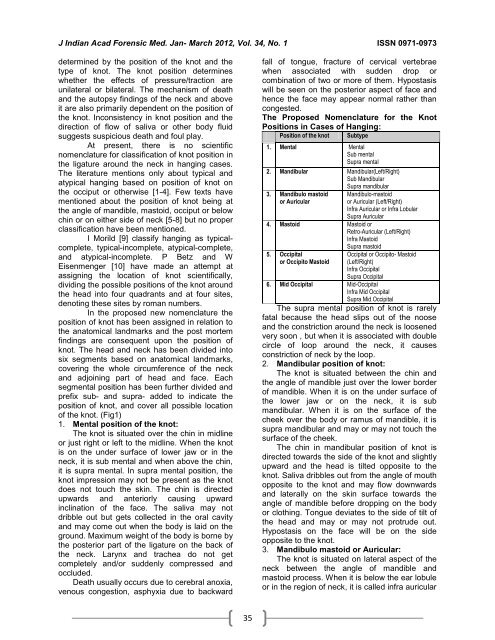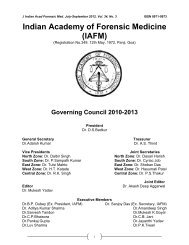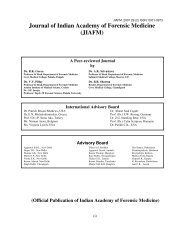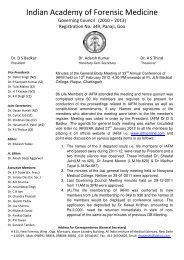Indian Academy of Forensic Medicine (IAFM) - Official website of IAFM
Indian Academy of Forensic Medicine (IAFM) - Official website of IAFM
Indian Academy of Forensic Medicine (IAFM) - Official website of IAFM
Create successful ePaper yourself
Turn your PDF publications into a flip-book with our unique Google optimized e-Paper software.
J <strong>Indian</strong> Acad <strong>Forensic</strong> Med. Jan- March 2012, Vol. 34, No. 1 ISSN 0971-0973<br />
determined by the position <strong>of</strong> the knot and the<br />
type <strong>of</strong> knot. The knot position determines<br />
whether the effects <strong>of</strong> pressure/traction are<br />
unilateral or bilateral. The mechanism <strong>of</strong> death<br />
and the autopsy findings <strong>of</strong> the neck and above<br />
it are also primarily dependent on the position <strong>of</strong><br />
the knot. Inconsistency in knot position and the<br />
direction <strong>of</strong> flow <strong>of</strong> saliva or other body fluid<br />
suggests suspicious death and foul play.<br />
At present, there is no scientific<br />
nomenclature for classification <strong>of</strong> knot position in<br />
the ligature around the neck in hanging cases.<br />
The literature mentions only about typical and<br />
atypical hanging based on position <strong>of</strong> knot on<br />
the occiput or otherwise [1-4]. Few texts have<br />
mentioned about the position <strong>of</strong> knot being at<br />
the angle <strong>of</strong> mandible, mastoid, occiput or below<br />
chin or on either side <strong>of</strong> neck [5-8] but no proper<br />
classification have been mentioned.<br />
I Morild [9] classify hanging as typicalcomplete,<br />
typical-incomplete, atypical-complete,<br />
and atypical-incomplete. P Betz and W<br />
Eisenmenger [10] have made an attempt at<br />
assigning the location <strong>of</strong> knot scientifically,<br />
dividing the possible positions <strong>of</strong> the knot around<br />
the head into four quadrants and at four sites,<br />
denoting these sites by roman numbers.<br />
In the proposed new nomenclature the<br />
position <strong>of</strong> knot has been assigned in relation to<br />
the anatomical landmarks and the post mortem<br />
findings are consequent upon the position <strong>of</strong><br />
knot. The head and neck has been divided into<br />
six segments based on anatomical landmarks,<br />
covering the whole circumference <strong>of</strong> the neck<br />
and adjoining part <strong>of</strong> head and face. Each<br />
segmental position has been further divided and<br />
prefix sub- and supra- added to indicate the<br />
position <strong>of</strong> knot, and cover all possible location<br />
<strong>of</strong> the knot. (Fig1)<br />
1. Mental position <strong>of</strong> the knot:<br />
The knot is situated over the chin in midline<br />
or just right or left to the midline. When the knot<br />
is on the under surface <strong>of</strong> lower jaw or in the<br />
neck, it is sub mental and when above the chin,<br />
it is supra mental. In supra mental position, the<br />
knot impression may not be present as the knot<br />
does not touch the skin. The chin is directed<br />
upwards and anteriorly causing upward<br />
inclination <strong>of</strong> the face. The saliva may not<br />
dribble out but gets collected in the oral cavity<br />
and may come out when the body is laid on the<br />
ground. Maximum weight <strong>of</strong> the body is borne by<br />
the posterior part <strong>of</strong> the ligature on the back <strong>of</strong><br />
the neck. Larynx and trachea do not get<br />
completely and/or suddenly compressed and<br />
occluded.<br />
Death usually occurs due to cerebral anoxia,<br />
venous congestion, asphyxia due to backward<br />
35<br />
fall <strong>of</strong> tongue, fracture <strong>of</strong> cervical vertebrae<br />
when associated with sudden drop or<br />
combination <strong>of</strong> two or more <strong>of</strong> them. Hypostasis<br />
will be seen on the posterior aspect <strong>of</strong> face and<br />
hence the face may appear normal rather than<br />
congested.<br />
The Proposed Nomenclature for the Knot<br />
Positions in Cases <strong>of</strong> Hanging:<br />
Position <strong>of</strong> the knot Subtype<br />
1. Mental a) Mental<br />
b) Sub mental<br />
c) Supra mental<br />
2. Mandibular a) Mandibular(Left/Right)<br />
b) Sub Mandibular<br />
3. Mandibulo mastoid<br />
or Auricular<br />
c) Supra mandibular<br />
a) Mandibulo-mastoid<br />
or Auricular (Left/Right)<br />
b) Infra Auricular or Infra Lobular<br />
c) Supra Auricular<br />
4. Mastoid a) Mastoid or<br />
Retro-Auricular (Left/Right)<br />
b) Infra Mastoid<br />
5. Occipital<br />
or Occipito Mastoid<br />
c) Supra mastoid<br />
a) Occipital or Occipito- Mastoid<br />
(Left/Right)<br />
b) Infra Occipital<br />
c) Supra Occipital<br />
6. Mid Occipital a) Mid-Occipital<br />
b) Infra Mid Occipital<br />
c) Supra Mid Occipital<br />
The supra mental position <strong>of</strong> knot is rarely<br />
fatal because the head slips out <strong>of</strong> the noose<br />
and the constriction around the neck is loosened<br />
very soon , but when it is associated with double<br />
circle <strong>of</strong> loop around the neck, it causes<br />
constriction <strong>of</strong> neck by the loop.<br />
2. Mandibular position <strong>of</strong> knot:<br />
The knot is situated between the chin and<br />
the angle <strong>of</strong> mandible just over the lower border<br />
<strong>of</strong> mandible. When it is on the under surface <strong>of</strong><br />
the lower jaw or on the neck, it is sub<br />
mandibular. When it is on the surface <strong>of</strong> the<br />
cheek over the body or ramus <strong>of</strong> mandible, it is<br />
supra mandibular and may or may not touch the<br />
surface <strong>of</strong> the cheek.<br />
The chin in mandibular position <strong>of</strong> knot is<br />
directed towards the side <strong>of</strong> the knot and slightly<br />
upward and the head is tilted opposite to the<br />
knot. Saliva dribbles out from the angle <strong>of</strong> mouth<br />
opposite to the knot and may flow downwards<br />
and laterally on the skin surface towards the<br />
angle <strong>of</strong> mandible before dropping on the body<br />
or clothing. Tongue deviates to the side <strong>of</strong> tilt <strong>of</strong><br />
the head and may or may not protrude out.<br />
Hypostasis on the face will be on the side<br />
opposite to the knot.<br />
3. Mandibulo mastoid or Auricular:<br />
The knot is situated on lateral aspect <strong>of</strong> the<br />
neck between the angle <strong>of</strong> mandible and<br />
mastoid process. When it is below the ear lobule<br />
or in the region <strong>of</strong> neck, it is called infra auricular









